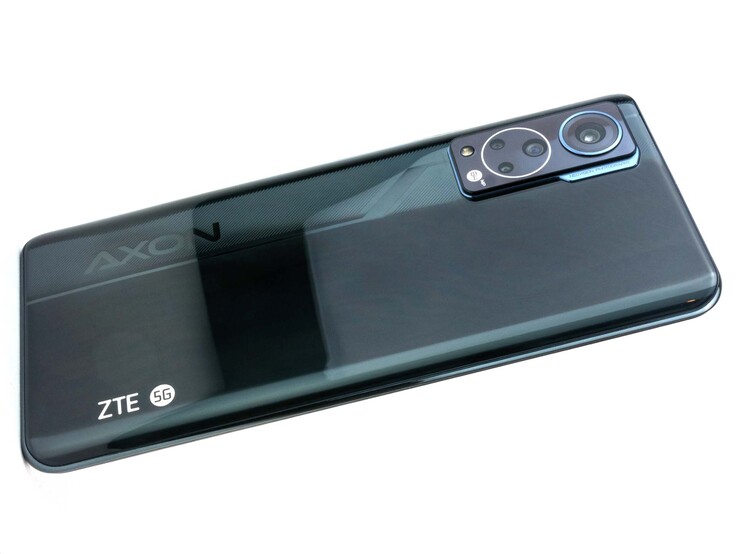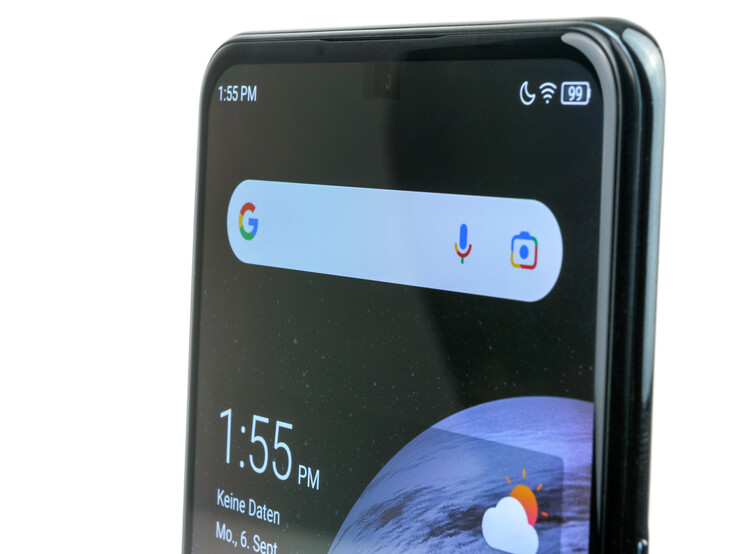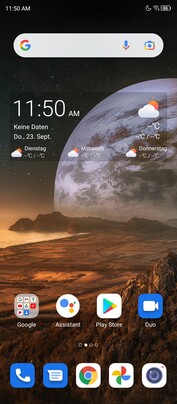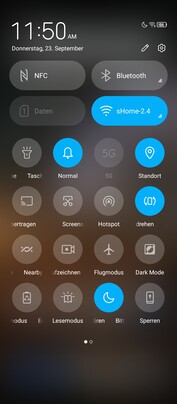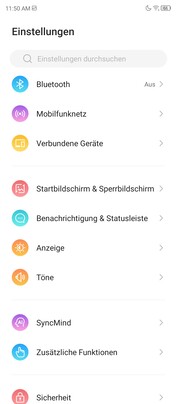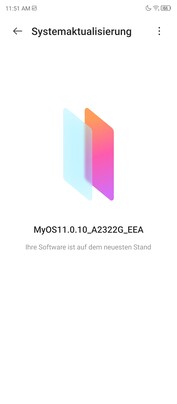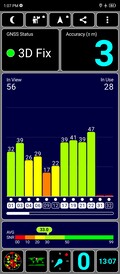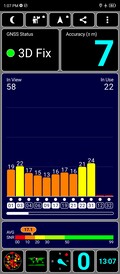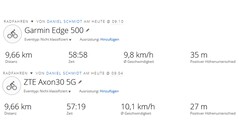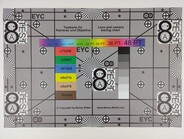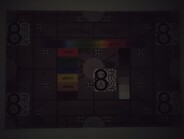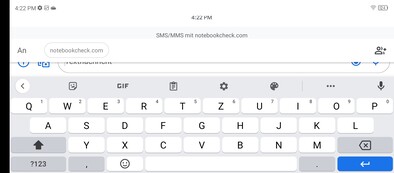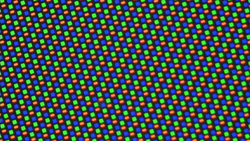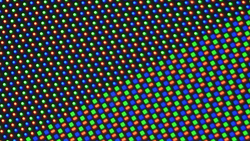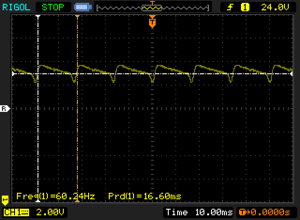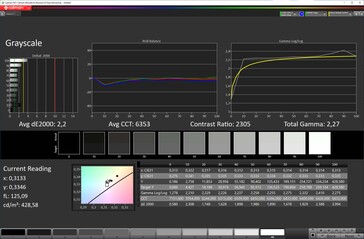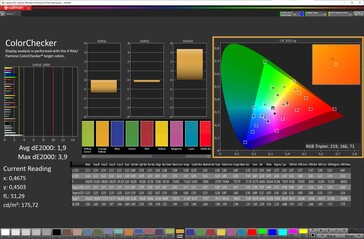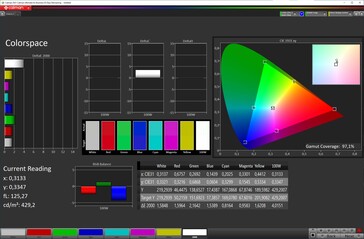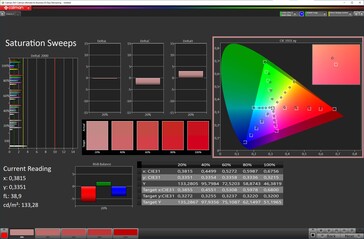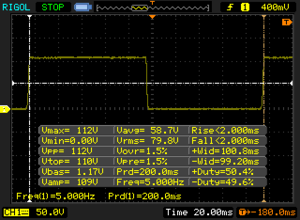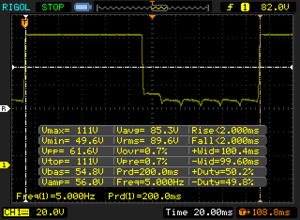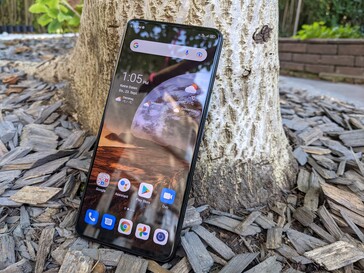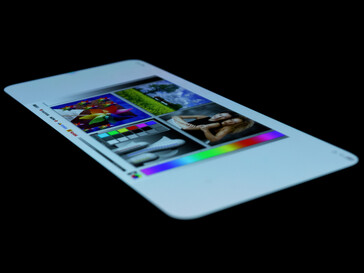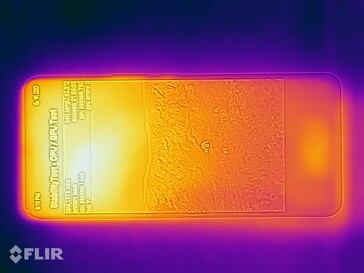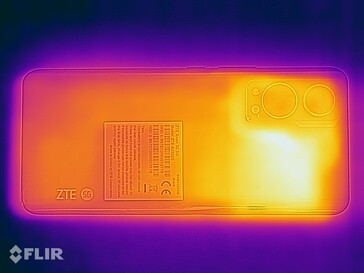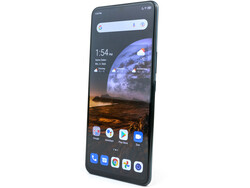ZTE Axon 30 5G smartphone review: Significantly improved under-display camera
While the ZTE Axon 20 was still priced in the mid-range and mainly focused on scoring points with a large display and the first under-display camera (UDC), the new Axon 30 5G goes all out, considerably improving all features.
In return, the entry-level price increases to 499 Euros (~$584), for which the ZTE smartphone is available with 8 GB of RAM and 128 GB of internal storage. Users who want more can also buy the model with 12 GB and 256 GB, respectively, which costs 599 Euros (~$701).
Possible contenders in comparison
Rating | Date | Model | Weight | Drive | Size | Resolution | Price |
|---|---|---|---|---|---|---|---|
| 86.6 % v7 (old) | 09 / 2021 | ZTE Axon 30 5G SD 870, Adreno 650 | 189 g | 128 GB UFS 3.1 Flash | 6.92" | 2460x1080 | |
| 77.2 % v7 (old) | 01 / 2021 | ZTE Axon 20 T618, Mali-G52 MP2 | 198 g | 128 GB eMMC Flash | 6.92" | 2460x1080 | |
| 85.1 % v7 (old) | 08 / 2021 | OnePlus Nord 2 5G Dimensity 1200, Mali-G77 MP9 | 189 g | 256 GB UFS 3.1 Flash | 6.43" | 2400x1080 | |
| 81.1 % v7 (old) | 08 / 2021 | Nokia XR20 SD 480, Adreno 619 | 248 g | 128 GB UFS 2.1 Flash | 6.67" | 2400x1080 | |
| 83 % v7 (old) | 04 / 2021 | Samsung Galaxy A52 5G SD 750G 5G, Adreno 619 | 189 g | 128 GB UFS 2.1 Flash | 6.50" | 2400x1080 |
Case - Axon 30 with prominent camera design
The design of the ZTE Axon 30 5G's rear camera is striking, and it stands in contrast to the almost invisible camera at the front. The latter has been noticeably improved compared to the predecessor. It's barely visible when viewed from a straight angle, and we also like it much better than the one in the Galaxy Z Fold3.
The workmanship of the Axon 30 is pleasing. The frame is made of coated aluminum, the back of plastic, and the front is protected by an unspecified type of glass. Only the black plastic bezel around the display is a bit bothersome. Nevertheless, the gap dimensions are very uniform, and the ZTE smartphone only creaks audibly when you try to twist it.
A special protection against dust and water is not provided.
Connectivity - USB 3.2 and microSD support for the ZTE smartphone
ZTE has equipped the Axon 30 5G with a high-performance USB 3.2 port (Gen. 1, up to 5 Gb/s) that supports OTG as well as wired image output via HDMI and DisplayPort interfaces.
In comparison with the predecessor, the smartphone is also DRM-certified, so that accordingly protected content can be reproduced in high resolution.
Although the Axon 30 does not have an audio jack, ZTE includes the corresponding adapter.
microSD card reader
The microSD slot achieves comparatively high copy speeds in combination with our reference card, the Angelbird AV Pro V60. However, the read speeds in the CPDT test are quite slow. In addition, the exFAT file system is supported.
| SD Card Reader - average JPG Copy Test (av. of 3 runs) | |
| ZTE Axon 30 5G (Angelbird AV Pro V60) | |
| Samsung Galaxy A52 5G (Toshiba Exceria Pro M501) | |
| Nokia XR20 (Angelbird V60) | |
Cross Platform Disk Test (CPDT)
Software - ZTE Axon 30 with Android 11 and MyOS 11
The ZTE Axon 30 5G comes with Google Android 11 and the in-house MyOS 11 user interface. The new UI has a clear design and is reminiscent of MIUI. At the time of our test, the security patches are at the level of July 1, 2021, and are therefore still quite up to date. The manufacturer hasn't stated any details regarding the period for which updates will be provided or the intervals between them. Experience shows that security updates should be delivered rather irregularly for the Axon, and that another major update will probably not be released after Android 12.
ZTE barely installs any third-party apps. Only WPS Office is preinstalled alongside some Google apps.
Communication and GNSS - Fast connectivity and dual-band GNSS
The ZTE Axon 30 5G supports all current standards for mobile data exchange, and it offers a decent frequency coverage that supports all common bands. The reception quality didn't show any issues in the test.
Although the Wi-Fi 6 module works very stably in combination with our Netgear Nighthawk AX12 reference router, it doesn't take full advantage of the standard's possibilities.
| Networking | |
| iperf3 transmit AX12 | |
| OnePlus Nord 2 5G | |
| ZTE Axon 30 5G | |
| Nokia XR20 | |
| ZTE Axon 20 | |
| Samsung Galaxy A52 5G | |
| iperf3 receive AX12 | |
| OnePlus Nord 2 5G | |
| ZTE Axon 30 5G | |
| Nokia XR20 | |
| Samsung Galaxy A52 5G | |
| ZTE Axon 20 | |
The ZTE Axon 30 5G determines its position very quickly and accurately outdoors. It takes a bit longer indoors, but the smartphone still proves to be quite accurate in that case as well.
The Axon has to face the comparison with the Garmin Edge 500 on a short bike ride. Despite its dual-band GNSS, it shows larger deviations than the bike computer. This could be due to the fact that it switches back to single-band operation when tracking for extended periods of time.
Telephone and call quality
The ZTE Axon 30 5G has a hybrid SIM slot, and it can accommodate either two nano SIMs or a microSD card instead of the second SIM. Features like VoLTE and WLAN calling are supported, but not an eSIM.
When held to the ear, call quality is very good in quiet environments. Even low ambient noise is filtered out by the rather aggressive noise suppression, but this also results in the Axon user's voice sounding very nasal and muffled. Louder background noise can also lead to small interruptions. There's noticeable reverberation in speaker mode, and the user's voice is transmitted in a very tinny manner.
Cameras - Brand-new UD camera
The front of the ZTE Axon 30 5G features an enhanced under-display camera (UDC) that ensures an uninterrupted view of the screen and is also meant to enable good selfies. The camera uses pixel-binning for higher light sensitivity, and it manages to take better pictures than its predecessor, but its quality is still average to mediocre. The photos are dominated by oversharpened contours, they are too bright, and colors are displayed correspondingly pale. At best, it records videos in Full HD (30 FPS).
The quad-camera setup on the back consists of a 64 MP lens with Sony's IMX682 sensor, an ultra wide-angle lens, a macro lens, and a lens for capturing depth information. Pictures taken with the main camera look a bit too soft; however, it still provides a decent digital zoom (max. 20x magnification), but it struggles to focus in low light. As is typical for this price range, the ultra wide-angle camera is characterized by a low amount of details and chromatic aberrations at the edges of subjects.
Videos can be recorded in Ultra HD at up to 60 FPS.
Image comparison
Choose a scene and navigate within the first image. One click changes the position on touchscreens. One click on the zoomed-in image opens the original in a new window. The first image shows the scaled photograph of the test device.
Wide angleWide angleUltra wide angle5x zoomLow light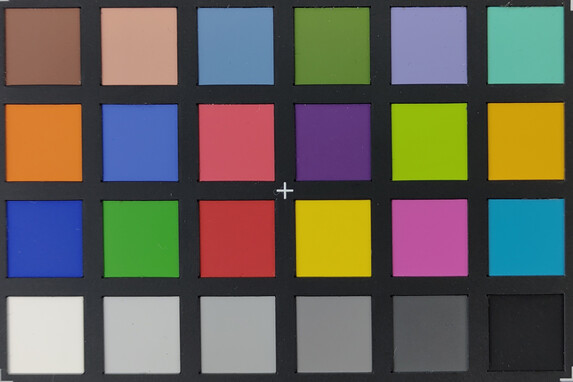
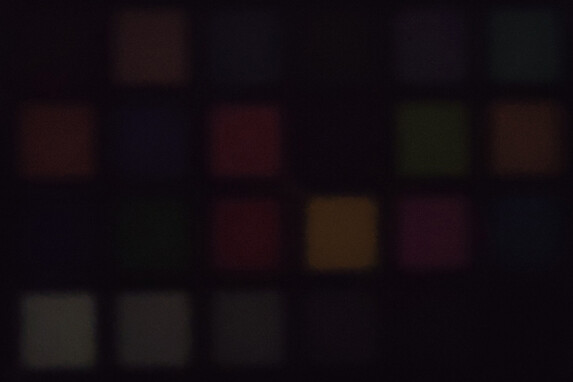
Accessories and warranty - Generous amount of accessories
The ZTE Axon 30 5G comes with a modular 65-watt power adapter, a clear plastic case, a USB cable (Type-C on both ends), a audio jack adapter, a SIM tool, and a headset (3.5 mm). A compatible screen protector (7 Euros (~$8)) and a darker case (10 Euros (~$12)) are optionally available directly from ZTE.
There is a 24-month warranty.
Input devices and handling - Optical fingerprint scanner for the Axon 30
The capacitive touchscreen of the ZTE Axon 30 5G has very good gliding properties, and it responds to touches quickly and accurately. Google's GBoard is preinstalled as the keyboard, but it can also be replaced with another layout from the Play Store.
An optical fingerprint sensor has been integrated into the display for biometric security; while it does a good job, it could be a bit faster. Alternatively or additionally, you can also unlock the device via the front-facing camera.
Users can navigate the system using gestures as well as the classic navigation buttons. Both options can be further customized by the user.
Display - AMOLED with permanent DC dimming
The 6.92-inch 120 Hz AMOLED display of the ZTE Axon 30 5G makes use of a Full HD Plus resolution. Depending on the content being displayed, the camera integrated into the panel is barely visible or not visible at all, but the transitions are still clearly discernible in the subpixel structure.
Unfortunately, the display only has a low brightness potential, and it behaves the same regardless of whether the ambient light sensor is activated or manual control is used. Similarly, higher peak values aren't detectable in the APL measurements, which will provide for a less thrilling HDR reproduction in everyday use, especially since the Axon nominally supports HDR10+.
OLED flickering is compensated for with a permanent DC dimming mode that can't be deactivated.
| |||||||||||||||||||||||||
Brightness Distribution: 94 %
Center on Battery: 455 cd/m²
Contrast: ∞:1 (Black: 0 cd/m²)
ΔE ColorChecker Calman: 1.9 | ∀{0.5-29.43 Ø4.79}
ΔE Greyscale Calman: 2.2 | ∀{0.09-98 Ø5}
99.8% sRGB (Calman 2D)
Gamma: 2.27
CCT: 6353 K
| ZTE Axon 30 5G AMOLED, 2460x1080, 6.9" | ZTE Axon 20 OLED, 2460x1080, 6.9" | OnePlus Nord 2 5G AMOLED, 2400x1080, 6.4" | Nokia XR20 IPS, 2400x1080, 6.7" | Samsung Galaxy A52 5G Super AMOLED, 2400x1080, 6.5" | |
|---|---|---|---|---|---|
| Screen | -56% | -21% | -43% | 7% | |
| Brightness middle (cd/m²) | 455 | 402 -12% | 594 31% | 599 32% | 744 64% |
| Brightness (cd/m²) | 458 | 405 -12% | 594 30% | 598 31% | 749 64% |
| Brightness Distribution (%) | 94 | 96 2% | 99 5% | 99 5% | 98 4% |
| Black Level * (cd/m²) | 0.33 | ||||
| Colorchecker dE 2000 * | 1.9 | 3.5 -84% | 2.74 -44% | 4.52 -138% | 2.2 -16% |
| Colorchecker dE 2000 max. * | 3.9 | 7.7 -97% | 6 -54% | 7.6 -95% | 7 -79% |
| Greyscale dE 2000 * | 2.2 | 5.1 -132% | 4.2 -91% | 4.2 -91% | 2.1 5% |
| Gamma | 2.27 97% | 2.33 94% | 2.278 97% | 2.279 97% | 2.06 107% |
| CCT | 6353 102% | 7480 87% | 7322 89% | 7309 89% | 6516 100% |
| Contrast (:1) | 1815 |
* ... smaller is better
Screen Flickering / PWM (Pulse-Width Modulation)
| Screen flickering / PWM detected | 60.2 Hz | ≤ 100 % brightness setting | |
The display backlight flickers at 60.2 Hz (worst case, e.g., utilizing PWM) Flickering detected at a brightness setting of 100 % and below. There should be no flickering or PWM above this brightness setting. The frequency of 60.2 Hz is very low, so the flickering may cause eyestrain and headaches after extended use. In comparison: 53 % of all tested devices do not use PWM to dim the display. If PWM was detected, an average of 8152 (minimum: 5 - maximum: 343500) Hz was measured. | |||
By default, the content on the AMOLED display is a bit too cool. If you set the color temperature to Warm in the settings, you will get a balanced and natural color reproduction without having to give up the large DCI-P3 (10-bit) color space.
Display Response Times
| ↔ Response Time Black to White | ||
|---|---|---|
| 4 ms ... rise ↗ and fall ↘ combined | ↗ 2 ms rise | |
| ↘ 2 ms fall | ||
| The screen shows very fast response rates in our tests and should be very well suited for fast-paced gaming. In comparison, all tested devices range from 0.1 (minimum) to 240 (maximum) ms. » 15 % of all devices are better. This means that the measured response time is better than the average of all tested devices (20.3 ms). | ||
| ↔ Response Time 50% Grey to 80% Grey | ||
| 4 ms ... rise ↗ and fall ↘ combined | ↗ 2 ms rise | |
| ↘ 2 ms fall | ||
| The screen shows very fast response rates in our tests and should be very well suited for fast-paced gaming. In comparison, all tested devices range from 0.165 (minimum) to 636 (maximum) ms. » 14 % of all devices are better. This means that the measured response time is better than the average of all tested devices (31.7 ms). | ||
The ZTE Axon's screen remains easy to view outdoors as long as the sun isn't too bright. If that is the case, the only option left is to move to a more shaded place.
The viewing-angle stability of the ZTE smartphone is very good. Only a slight blue tint is visible at flat viewing angles, and brightness drops minimally here as well.
Performance - The Axon 30 5G is equipped with fast storage and a fast SoC
The ZTE Axon 30 5G is powered by a fast Snapdragon 870 5G, and depending on the configuration variant, it can access either 8 or 12 GB of RAM. The ZTE smartphone performs as expected in the benchmarks, and it also impresses with a high system speed.
Gaming performance shouldn't be affected either, since the Adreno 650 was already included in last year's top SoCs, and it's still one of the fastest of its kind.
| AImark - Score v2.x (sort by value) | |
| ZTE Axon 30 5G | |
| ZTE Axon 20 | |
| ZTE Axon 20 | |
| OnePlus Nord 2 5G | |
| Nokia XR20 | |
| Samsung Galaxy A52 5G | |
| Xiaomi Poco F3 | |
| Average Qualcomm Snapdragon 870 5G (111838 - 123847, n=9) | |
| JetStream 1.1 - Total Score | |
| Average Qualcomm Snapdragon 870 5G (105.1 - 184.5, n=9) | |
| ZTE Axon 30 5G (Chrome 92) | |
| OnePlus Nord 2 5G (Chrome 92) | |
| Xiaomi Poco F3 (Chrome 90) | |
| Samsung Galaxy A52 5G (Chrome 89) | |
| Nokia XR20 (Chrome 92) | |
| ZTE Axon 20 (Chrome 87) | |
| WebXPRT 3 - Overall | |
| Average of class Smartphone (38 - 380, n=40, last 2 years) | |
| Average Qualcomm Snapdragon 870 5G (94 - 155, n=13) | |
| Xiaomi Poco F3 (Chrome 90) | |
| ZTE Axon 30 5G (Chrome 92) | |
| Samsung Galaxy A52 5G (Chrome 89) | |
| Nokia XR20 (Chrome 92) | |
| OnePlus Nord 2 5G (Chrome 92) | |
| ZTE Axon 20 (Chrome 87) | |
| Octane V2 - Total Score | |
| Average of class Smartphone (2228 - 121337, n=202, last 2 years) | |
| Average Qualcomm Snapdragon 870 5G (20543 - 41256, n=13) | |
| ZTE Axon 30 5G (Chrome 92) | |
| Xiaomi Poco F3 (Chrome 90) | |
| OnePlus Nord 2 5G (Chrome 92) | |
| Nokia XR20 (Chrome 92) | |
| Samsung Galaxy A52 5G (Chrome 89) | |
| ZTE Axon 20 (Chrome 87) | |
| Mozilla Kraken 1.1 - Total | |
| ZTE Axon 20 (Chrome 87) | |
| Samsung Galaxy A52 5G (Chrome 89) | |
| Nokia XR20 (Chrome 92) | |
| OnePlus Nord 2 5G (Chrome 92) | |
| Xiaomi Poco F3 (Chrome 90) | |
| ZTE Axon 30 5G (Chrome 92) | |
| Average Qualcomm Snapdragon 870 5G (1055 - 1792, n=13) | |
| Average of class Smartphone (257 - 28190, n=157, last 2 years) | |
* ... smaller is better
The ZTE Axon 30 5G's integrated UFS 3.1 storage is a huge improvement over its predecessor, and except for the writing of small data sets, it offers above-average speeds.
| ZTE Axon 30 5G | ZTE Axon 20 | OnePlus Nord 2 5G | Nokia XR20 | Samsung Galaxy A52 5G | Average 128 GB UFS 3.1 Flash | Average of class Smartphone | |
|---|---|---|---|---|---|---|---|
| AndroBench 3-5 | -88% | 19% | -43% | -32% | 1% | 61% | |
| Sequential Read 256KB (MB/s) | 1712 | 106.7 -94% | 1827 7% | 485 -72% | 927 -46% | 1586 ? -7% | 2202 ? 29% |
| Sequential Write 256KB (MB/s) | 765 | 202.3 -74% | 1256 64% | 452 -41% | 484.6 -37% | 763 ? 0% | 1819 ? 138% |
| Random Read 4KB (MB/s) | 251.5 | 25.35 -90% | 223.7 -11% | 174.8 -30% | 176.1 -30% | 243 ? -3% | 292 ? 16% |
| Random Write 4KB (MB/s) | 208.9 | 9.56 -95% | 239 14% | 146.2 -30% | 179.2 -14% | 241 ? 15% | 334 ? 60% |
Emissions - Stable performance and decent sound
Temperature
The ZTE Axon 30 5G can get very warm under continuous load, reaching up to 43 °C (~109 °F) on the surface in some areas. However, this value isn't critical, especially since it suggests that the heat generated inside the device is being well dissipated, which is reflected in performance remaining stable at all times.
(±) The maximum temperature on the upper side is 42.2 °C / 108 F, compared to the average of 35.2 °C / 95 F, ranging from 21.9 to 247 °C for the class Smartphone.
(±) The bottom heats up to a maximum of 43 °C / 109 F, compared to the average of 34 °C / 93 F
(+) In idle usage, the average temperature for the upper side is 29.3 °C / 85 F, compared to the device average of 32.9 °C / 91 F.
Speaker
The mono speaker at the bottom of the smartphone provides a pleasing reproduction of media content at medium volumes, but it tends to distort at higher levels.
USB-C is available for wired headphones, for which ZTE includes an audio jack adapter in the box. The audio codecs SBC, AAC, aptX, aptX HD, aptX Adaptive, aptX TWS+, and LDAC are supported when using Bluetooth.
ZTE Axon 30 5G audio analysis
(+) | speakers can play relatively loud (90.4 dB)
Bass 100 - 315 Hz
(-) | nearly no bass - on average 25% lower than median
(±) | linearity of bass is average (7.3% delta to prev. frequency)
Mids 400 - 2000 Hz
(+) | balanced mids - only 4.8% away from median
(+) | mids are linear (4.4% delta to prev. frequency)
Highs 2 - 16 kHz
(±) | higher highs - on average 8.8% higher than median
(+) | highs are linear (2% delta to prev. frequency)
Overall 100 - 16.000 Hz
(±) | linearity of overall sound is average (20.1% difference to median)
Compared to same class
» 32% of all tested devices in this class were better, 9% similar, 59% worse
» The best had a delta of 11%, average was 35%, worst was 134%
Compared to all devices tested
» 51% of all tested devices were better, 8% similar, 41% worse
» The best had a delta of 4%, average was 24%, worst was 134%
Samsung Galaxy A52 5G audio analysis
(+) | speakers can play relatively loud (89 dB)
Bass 100 - 315 Hz
(-) | nearly no bass - on average 27.3% lower than median
(±) | linearity of bass is average (11.4% delta to prev. frequency)
Mids 400 - 2000 Hz
(±) | reduced mids - on average 6.2% lower than median
(+) | mids are linear (4.4% delta to prev. frequency)
Highs 2 - 16 kHz
(±) | higher highs - on average 5% higher than median
(+) | highs are linear (3.3% delta to prev. frequency)
Overall 100 - 16.000 Hz
(±) | linearity of overall sound is average (19.3% difference to median)
Compared to same class
» 25% of all tested devices in this class were better, 9% similar, 66% worse
» The best had a delta of 11%, average was 35%, worst was 134%
Compared to all devices tested
» 46% of all tested devices were better, 8% similar, 47% worse
» The best had a delta of 4%, average was 24%, worst was 134%
Battery life - Turbo fast charging with the Axon 30 5G
Energy consumption
Power consumption in the Axon 30 5G is quite low in most cases. Only at minimum panel brightness is it likely to be a bit lower, but this is probably due to the lack of adaptive control in the 120 Hz display.
The smartphone supports fast charging at up to 65 watts, and it comes with the appropriate power adapter in the box. Wireless charging is not supported, though.
| Off / Standby | |
| Idle | |
| Load |
|
Key:
min: | |
| ZTE Axon 30 5G 4200 mAh | ZTE Axon 20 4220 mAh | OnePlus Nord 2 5G 4500 mAh | Nokia XR20 4630 mAh | Samsung Galaxy A52 5G 4500 mAh | Average Qualcomm Snapdragon 870 5G | Average of class Smartphone | |
|---|---|---|---|---|---|---|---|
| Power Consumption | -6% | -9% | 20% | -6% | -48% | -20% | |
| Idle Minimum * (Watt) | 1.05 | 1.07 -2% | 0.8 24% | 0.7 33% | 0.92 12% | 1.23 ? -17% | 0.851 ? 19% |
| Idle Average * (Watt) | 1.23 | 1.7 -38% | 1.2 2% | 1.1 11% | 1.78 -45% | 2.17 ? -76% | 1.431 ? -16% |
| Idle Maximum * (Watt) | 1.24 | 1.75 -41% | 1.6 -29% | 1.6 -29% | 1.81 -46% | 2.49 ? -101% | 1.61 ? -30% |
| Load Average * (Watt) | 4.76 | 3.97 17% | 5.7 -20% | 2.7 43% | 3.86 19% | 6.39 ? -34% | 7.08 ? -49% |
| Load Maximum * (Watt) | 8.79 | 5.77 34% | 10.9 -24% | 4.9 44% | 6.14 30% | 9.94 ? -13% | 11.1 ? -26% |
* ... smaller is better
Energy consumption: Geekbench (150 cd/m²)
Energy consumption: GFXBench (150 cd/m²)
Battery life
The ZTE Axon 30 5G doesn't perform outstandingly in our real-world Wi-Fi test with the display brightness adjusted (150 cd/m²), but it still delivers a good runtime that should safely get users through the whole day.
| ZTE Axon 30 5G 4200 mAh | ZTE Axon 20 4220 mAh | OnePlus Nord 2 5G 4500 mAh | Nokia XR20 4630 mAh | Samsung Galaxy A52 5G 4500 mAh | |
|---|---|---|---|---|---|
| Battery runtime | -15% | 45% | 41% | 7% | |
| WiFi v1.3 (h) | 11 | 9.4 -15% | 16 45% | 15.5 41% | 11.8 7% |
| Reader / Idle (h) | 32.1 | 29.8 | 32 | ||
| H.264 (h) | 18.8 | 14.9 | 17.5 | ||
| Load (h) | 4.5 | 5 | 5.4 |
Pros
Cons
Verdict - Good overall package with UD camera
Compared with the Axon 20, the ZTE Axon 30 5G has been improved in many areas, and it now offers a good as well as modern overall package. The fast Qualcomm SoC ensures a strong system and gaming performance, the accurate 120 Hz panel provides a smooth image, and the under-display camera is now well hidden and hardly visible.
The ZTE Axon 30 5G offers more than just a well-hidden UD camera.
Nevertheless, ZTE has to face some criticism here. Although the UDC's imaging performance has improved, it's still not truly good. The main camera on the back is quite decent, but we still see room for improvement when it comes to image processing.
If you're looking for a smartphone with a large as well as uninterrupted display, and you don't want to make any compromises in terms of system speed, you should take a closer look at the Axon 30 5G. Other strong alternatives are the OnePlus Nord 2 and the Galaxy A52 5G.
Price and availability
At the time of writing, the ZTE Axon 30 5G is officially available directly from the manufacturer for a starting price of $499 (8/128GB). Alternatively, you can also wait for the device to become available on Amazon or newegg, for example.
ZTE Axon 30 5G
- 08/31/2022 v7 (old)
Daniel Schmidt




